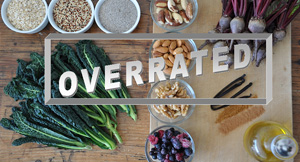How to Make Real-Food Meals that are Adaptable to Your Lifestyle

Health & Lifestyle
484 week ago — 6 min read
Rapid advancement in civilization and technology has transformed the way we live. One such advancement is convenience foods, or “processed food”, of which intake is rising at an alarming rise. Although processed foods are easy and tasty, they do come at a price. Packaged foods contain ingredients that aim to increase the shelf life of the item, but in turn harm our body. A whopping 70% of our food is processed, contributing to the ever-increasing obesity epidemic. Even if you have decided to lead a healthier, a simple trip to the grocery store can remind you why it is hard to avoid 'processed food'.
What Is Real Food?
“Whole foods which do not have an ingredient label, and have been raised locally by humans without any artificial sweeteners, a range of naturally dried fruits and raw nuts, can be considered as real food.”
Simple Meal Planning For Your Lifestyle
Our career-oriented lifestyles make it difficult to manage time for personal well-being. This has resulted in several sedentary lifestyle diseases such as hypertension, diabetes, depression and malnutrition, which are predominantly common among both youths and professional working adults.
Extensive business travel, working back late at the office and handling back to back client meetings, results in limited meal prep time, meaning you either tend to skip meals or fill up with a quick burger/instant noodles/crisps/chocolate bar (tick which applies!). It’s time to pause and think: what type of nutrition is your body getting daily?
The Key To Easy, Tasty Real-Food Meals
- Say NO to refined Carbohydrates & Dietary Sodium: Refined sugars and starches such as crisps, white bread, and cakes, have a major negative impact on your body weight, blood pressure, and blood sugar. A DASH (Dietary Approaches to Stop Hypertension) diet for example, is an effective way to prevent the onset of hypertension. The DASH diet recommends meals which are low in sodium, and high in nutrient-dense foods containing calcium, potassium and/or magnesium, such as legumes, beans and vegetables. The healthy level of sodium required for proper body functioning is a mere 2.3 grams (about one teaspoon) each day. However, a majority of people tend to consume much more than what the body requires. People suffering from medical conditions such as kidney ailments, heart problems, hypertension can significantly benefit from a low sodium diet such as DASH.
- Smoothies: Because they are filled with essential vitamins and nutrients. A breakfast smoothie could be a great source of energy, whilst also allowing you the nutrients you need. Whole fruits provide natural sugar which the body could use throughout the day, and grains such as oats allow carbohydrates for energy. Mix it up with your choice of protein such as milk, yogurt, and add frozen fruits and/or greens.
- Salads: A green salad, containing farm fresh green vegetables could be a potent source of powerful antioxidants such as Vitamin C, Vitamin E, folic acid, and alpha- and beta- carotene. Fresh vegetables can be tossed with olive oil, balsamic vinegar, or mustards, and a dash of pepper. According to research, people whose diets comprise of fruits and vegetables typically have a lower risk of some cancers. Salads also play an important role in weight-maintenance and weight-loss as they are light in calories, but again nutrient-dense, thereby also beneficial for a healthy heart and cells.
- Soups & Stocks: Soups are a great way to pack in nutrients the light way. Vegetable or chicken stocks are the easiest to make at home, and you can also freeze them to use on those nights you are home late from the office. Homemade stock boosts your immune system, aid digestion, and increases protein intake. A bone stock is usually rich in calcium, magnesium, phosphorous and collagen. The stomach acids act on the bone broth and break down the calcium and other minerals, passing them into our body’s system. However, avoid consuming the packaged soups as they contain additives and can be higher in unnecessary carbohydrates, sodium, and saturated fats.
- Healthy Fats: For years, nutritionists have highlighted the importance of a low-fat diet towards losing weight and regulating cholesterol. However, what’s more important is to balance the intake of good and bad fat. While unhealthy fat significantly contributes towards cholesterol and other heart diseases, healthy fats are essential for physical and emotional goodness. Monounsaturated and polyunsaturated fat benefits insulin level, especially in case of type-2 diabetes. Naturally occurring healthy fats are derived from coconut and olive oil, avocados, nuts and seeds, salmon, and some dairy products (in moderation).
Conclusion
Be realistic, and appreciate that magic won’t happen overnight. However, aligning your food habits with your lifestyle, and essentially eliminating a dependency on artificial and processed food, is crucial for a healthy body and mind.
Protein and nutrient rich natural whole foods are far more effective in boosting energy levels, as opposed to processed, packaged, ready-to-eat foods, and energy drinks. Real food also plays a large role in controlling blood pressure, and moderate cholesterol. Now that you know that the packaged processed foods we buy off the shelves are full of chemicals, preservatives, unhealthy fats, and other harmful ingredients, you know that real-food meals are a better option for your lifestyle in that they can provide you with much needed energy and stamina to face back-to back meetings, late work nights, and frequent business travels. Every day is a new day and another chance to start fresh.
Article & image source: http://execfuel.net/2016/03/17/realfoodsforbusylifestyle/

Posted by
Karen AroneyAn accredited nutritionist, specializing in nutrition and better health for children, adults, time-poor professionals, and organizations. I use client-centric approach to enabling...
Network with SMEs mentioned in this article
View Karen 's profile
Other articles written by Karen Aroney
Top 8 Overrated 'Healthy Foods'
482 week ago
5 Don'ts When it Comes to Your Nutrition
483 week ago
Most read this week













Comments (1)
Share this content
Please login or Register to join the discussion